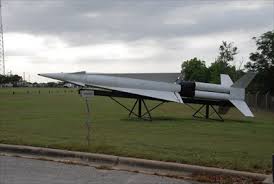 Nike Hercules missiles at bee caves Austin, TX
Nike Hercules missiles at bee caves Austin, TX
Story by: Mark Otte
AUSTIN, Texas--The little armory atop a hill, in the now-upscale Austin Bee Caves neighborhood, is seldom talked about, and even often unknown to both military and civilians. While the aging facility’s story actually starts south of Austin, much of its roots are lost in a swirl of Cold-War mystery.
The 12.5-acre site just off Bee Caves road, often colloquially called the “hilltop,” now houses the 71st troop command, but started life providing the city, and more importantly at the time, Bergstrom Air Force Base with protection from aerial attacks.
When visitors arrive at the gate today, the giant Nike-Hercules missile pointing skyward pays homage to the armory’s beginnings as the site for the integrated fire control center for the 10,000-pound missiles capable of hitting targets up to 90 miles away.
In the 1960s, the suburban hilltop had all of the necessary equipment to track targets, fire the missiles and would even house the troops needed to run the air defense equipment.
Complete with radars and generators, Defense Site BG-80 was just missing one thing: Missiles.
So, where were they?
The exact location of the launch site isn’t known. What is known is that the missiles were somewhere close.
Technical data on the launch capabilities suggest that the launch site and the integrated fire control needed to be separated by at least 0.56 miles but not more than 2.98 miles.
Pedro Garcia knows where they were, but he’s not saying. Garcia was stationed at the armory in late 1962 and 1963.
“The launching area was surrounded by berms 20 feet high,” Garcia said. “Every missile was inside what we called a globe tent, to hide it from the air and to protect them from the weather.”
To bring the missiles to “red status,” ready to launch, was as easy as pulling a rope.
“You just jerk the rope, the clips came off and the tent fell on both sides,” Garcia said. “Then the launcher started raising.”
Now at 74 years old, Garcia said that he thinks the surface to air missiles that were housed near the Bee Caves Armory were essential to the security of Bergstrom Air Force Base. What is now Austin Bergstrom International Airport, at the time was under Strategic Air Command and a prime target for Cold War foes.
“Back then, the Bee Caves Armory was instrumental, because of Bergstrom operating the way they did,” Garcia said. “I think it could have been a target for Russian bombs.”
With the days of the cold war squarely in the rear-view mirror, the soldiers of 71st Troop Command spend their days at the hilltop armory looking forward and preparing to defend the United States in future conflicts, pausing only occasionally to ponder the Cold War secrets that still surround the little Armory.